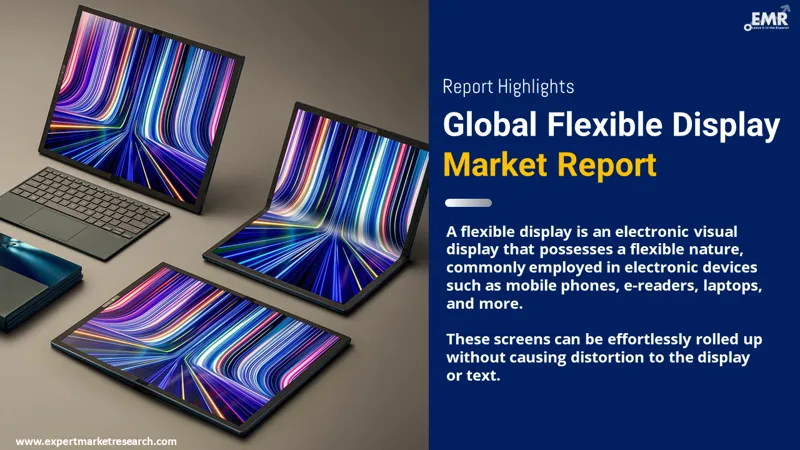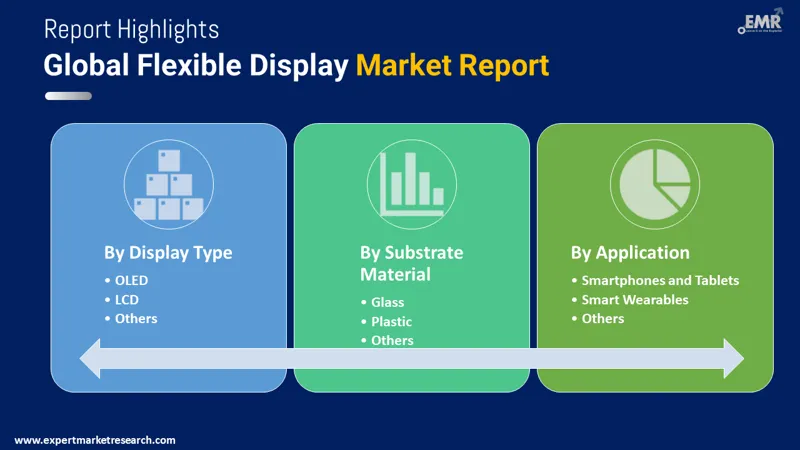
Consumer Insights
Uncover trends and behaviors shaping consumer choices today
Procurement Insights
Optimize your sourcing strategy with key market data
Industry Stats
Stay ahead with the latest trends and market analysis.
The global flexible display market attained a value of more than USD 23.13 Billion in 2025. The market is further expected to grow in the forecast period of 2026-2035 at a CAGR of 23.60% to reach over USD 192.47 Billion by 2035.
Base Year
Historical Period
Forecast Period
Compound Annual Growth Rate
23.6%
Value in USD Billion
2026-2035
*this image is indicative*
| Global Flexible Display Market Report Summary | Description | Value |
| Base Year | USD Billion | 2025 |
| Historical Period | USD Billion | 2019-2025 |
| Forecast Period | USD Billion | 2026-2035 |
| Market Size 2025 | USD Billion | 23.13 |
| Market Size 2035 | USD Billion | 192.47 |
| CAGR 2019-2025 | Percentage | XX% |
| CAGR 2026-2035 | Percentage | 23.60% |
| CAGR 2026-2035 - Market by Region | Asia Pacific | 25.1% |
| CAGR 2026-2035 - Market by Country | UK | 23.1% |
| CAGR 2026-2035 - Market by Country | USA | 22.4% |
| CAGR 2026-2035 - Market by Display Type | EPD (Electronic Paper Display) | 26.1% |
| CAGR 2026-2035 - Market by Application | Smart Wearables | 25.4% |
| Market Share by Country | France | 3.7% |
The flexible display industry is being driven by the expanding consumer electronics sector and the growing advancements in technology, such as the development of 3D displays that do not require special viewing glasses.
The increasing use of flexible display in several digital solutions such as smartphones and tablets, smart wearables, televisions, laptops, and other electronic devices is expected to bolster the market growth. The beneficial properties of flexible display such as its thin and lightweight composition, minimised propensity for breakage, along with an improved imaging quality have enhanced its demand in the production of these devices.

Read more about this report - REQUEST FREE SAMPLE COPY IN PDF
Geographically, the Asia Pacific is expected to be one of the fastest growing regions during the forecast period, driven by the increasing use of technology among consumers, especially in countries like India, China, and Japan. Also, China is one of the leading manufacturers of flexible display in the region, which is estimated to positively impact the industry growth.

Read more about this report - REQUEST FREE SAMPLE COPY IN PDF
Flexible display refers to an electronic visual display, which is flexible in nature. It is widely used in electronic devices like mobile phones, e-readers, laptops, and others. These screens can be rolled up very easily without distorting the screen or text.
Breakup by Display Type
Breakup by Substrate Material
Breakup by Application
Breakup by Region
| CAGR 2026-2035 - Market by | Display Type |
| EPD (Electronic Paper Display) | 26.1% |
| OLED | 23.9% |
| LCD | XX% |
| CAGR 2026-2035 - Market by | Application |
| Smart Wearables | 25.4% |
| Smartphones and Tablets | 24.1% |
| Televisions and Digital Signage Systems | XX% |
| Personal Computers and Laptops | XX% |
| Others | XX% |
| CAGR 2026-2035 - Market by | Region |
| Asia Pacific | 25.1% |
| Europe | 23.9% |
| North America | 22.7% |
| Latin America | XX% |
| Middle East and Africa | XX% |
| CAGR 2026-2035 - Market by | Country |
| UK | 23.1% |
| Germany | 22.8% |
| USA | 22.4% |
| Australia | 21.8% |
| Brazil | 20.2% |
| Canada | XX% |
| France | XX% |
| Italy | XX% |
| China | XX% |
| Japan | 19.8% |
| India | XX% |
| Saudi Arabia | XX% |
| Mexico | XX% |
The growing use of electronic devices such as PCs and smartphones around the globe, fuelled by the rapid digitalisation, is one of the major factors driving the growth of the flexible display industry. This can be attributed to the favourable properties of flexible displays. For instance, flexible displays are portable, thin, and lightweight. Also, they do not need a separate external light source in order to display an image. In addition, flexible displays incorporate an unbreakable and glass-free active-matrix display, which is a unique selling point for consumers. Moreover, advances in flexible electronics are leading to the development of flexible components such as flexible displays and sensors, which provides creative freedom to developers. They can be made using different materials like glass, plastic, and others and come in different varieties. For instance, OLED lights are very efficient because they are a self-emitting light source and are very flexible in nature. Additionally, the rapid technological advancements and the growing innovations to develop flexible displays are expected to bode well for the industry growth in the coming years.
| Market Share by | Country |
| France | 3.7% |
| USA | XX% |
| Canada | XX% |
| UK | XX% |
The report presents a detailed analysis of the following key players in the global flexible display market, looking into their capacity, market shares, and latest developments like capacity expansions, plant turnarounds, and mergers and acquisitions:
The comprehensive report looks into the macro and micro aspects of the industry. The EMR report gives an in-depth insight into the market by providing a SWOT analysis as well as an analysis of Porter’s Five Forces model.




*While we strive to always give you current and accurate information, the numbers depicted on the website are indicative and may differ from the actual numbers in the main report. At Expert Market Research, we aim to bring you the latest insights and trends in the market. Using our analyses and forecasts, stakeholders can understand the market dynamics, navigate challenges, and capitalize on opportunities to make data-driven strategic decisions.*
Get in touch with us for a customized solution tailored to your unique requirements and save upto 35%!
In 2025, the global flexible display market attained a value of more than USD 23.13 Billion.
The market is projected to grow at a CAGR of 23.60% between 2026 and 2035.
The market is estimated to witness a healthy growth in the forecast period of 2026-2035 to reach over USD 192.47 Billion by 2035.
The major drivers of the industry, such as the rising disposable incomes, increasing adoption of digital technology, growing retail sector, increasing demand for smartphones, minimised propensity for breakage, and growing technological innovations, are expected to aid the market growth.
The key market trends guiding the growth of the industry include the rapid digitalisation.
The major regions in the industry are North America, Latin America, the Middle East and Africa, Europe, and the Asia Pacific.
The significant types of flexible display include OLED, LCD, and EPD (Electronic Paper Display), among others.
The different substrate materials include glass, plastic, and others.
The major applications of the product include smartphones and tablets, smart wearables, televisions and digital signage systems, personal computers and laptops, and others.
The major players in the industry are LG Display Co., Ltd., Samsung Electronics Co. Ltd, Huawei Technologies Co. Ltd., Innolux Corporation, and Royole Corporation, among others.
Explore our key highlights of the report and gain a concise overview of key findings, trends, and actionable insights that will empower your strategic decisions.
| REPORT FEATURES | DETAILS |
| Base Year | 2025 |
| Historical Period | 2019-2025 |
| Forecast Period | 2026-2035 |
| Scope of the Report |
Historical and Forecast Trends, Industry Drivers and Constraints, Historical and Forecast Market Analysis by Segment:
|
| Breakup by Display Type |
|
| Breakup by Substrate Material |
|
| Breakup by Application |
|
| Breakup by Region |
|
| Market Dynamics |
|
| Competitive Landscape |
|
| Companies Covered |
|
| Report Price and Purchase Option | Explore our purchase options that are best suited to your resources and industry needs. |
| Delivery Format | Delivered as an attached PDF and Excel through email, with an option of receiving an editable PPT, according to the purchase option. |
Datasheet
One User
USD 2,499
USD 2,249
tax inclusive*
Single User License
One User
USD 3,999
USD 3,599
tax inclusive*
Five User License
Five User
USD 4,999
USD 4,249
tax inclusive*
Corporate License
Unlimited Users
USD 5,999
USD 5,099
tax inclusive*
*Please note that the prices mentioned below are starting prices for each bundle type. Kindly contact our team for further details.*
Flash Bundle
Small Business Bundle
Growth Bundle
Enterprise Bundle
*Please note that the prices mentioned below are starting prices for each bundle type. Kindly contact our team for further details.*
Flash Bundle
Number of Reports: 3
20%
tax inclusive*
Small Business Bundle
Number of Reports: 5
25%
tax inclusive*
Growth Bundle
Number of Reports: 8
30%
tax inclusive*
Enterprise Bundle
Number of Reports: 10
35%
tax inclusive*
How To Order

Select License Type
Choose the right license for your needs and access rights.

Click on ‘Buy Now’
Add the report to your cart with one click and proceed to register.

Select Mode of Payment
Choose a payment option for a secure checkout. You will be redirected accordingly.
Gain insights to stay ahead and seize opportunities.

Get insights & trends for a competitive edge.

Track prices with detailed trend reports.

Analyse trade data for supply chain insights.

Leverage cost reports for smart savings

Enhance supply chain with partnerships.

Connect For More Information
Our expert team of analysts will offer full support and resolve any queries regarding the report, before and after the purchase.
Our expert team of analysts will offer full support and resolve any queries regarding the report, before and after the purchase.
We employ meticulous research methods, blending advanced analytics and expert insights to deliver accurate, actionable industry intelligence, staying ahead of competitors.
Our skilled analysts offer unparalleled competitive advantage with detailed insights on current and emerging markets, ensuring your strategic edge.
We offer an in-depth yet simplified presentation of industry insights and analysis to meet your specific requirements effectively.
Share